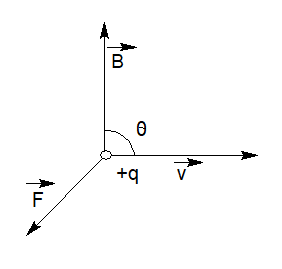
A very high magnetic field is applied to a stationary charge. Then the charge experiences
A.A force in the direction of the magnetic field
B.A force perpendicular to the magnetic field
C.A force in an arbitrary
D.No force
Answer
219.9k+ views
Hint: A very high magnetic field is a vector that describes the magnetic influence of charged particles in a uniform motion. When a charged particle moving relative to the magnetic field experiences a magnetic force, this force is known as the Lorentz force.
Complete answer:
Since when an electric field is stationary, the charged particle does not experience Lorentz force $F$. Even though there is a very high magnetic field applied, there is no magnetic force that acts on motionless charged particles.
Let a charged particle $q$ moves with a uniform velocity $\vec{v}$ in a magnetic field $\vec{B}$ the Lorentz force $\vec{F}$ experienced by particles can be expressed as:
$\vec{F}=q(\vec{v}\times \vec{B})$

Here a magnetic field is applied to a stationary charge, then $\vec{v}=0$
Therefore, the force experienced by a stationary charge is
$\vec{F}=q(0\times \vec{B})$
$\vec{F}=0$
That is, a stationary charge experiences no force in a very high magnetic field.
Thus, Option (D) is correct.
Additional information: Lorentz force only applicable for charged particles like electrons, protons etc. But it can not be applied to neutral particles like neutrons. The neutron’s charge is zero and it does not experience any force in a magnetic field. A neutron particle will traverse undeflected from its path.
Note: If a charged particle moves along the direction of the magnetic field, then the velocity vector is parallel to the magnetic field vector. In that case, the magnetic force experienced by the charged particle is also zero. This is because the angle between the velocity vector and magnetic field vector becomes zero.
Complete answer:
Since when an electric field is stationary, the charged particle does not experience Lorentz force $F$. Even though there is a very high magnetic field applied, there is no magnetic force that acts on motionless charged particles.
Let a charged particle $q$ moves with a uniform velocity $\vec{v}$ in a magnetic field $\vec{B}$ the Lorentz force $\vec{F}$ experienced by particles can be expressed as:
$\vec{F}=q(\vec{v}\times \vec{B})$

Here a magnetic field is applied to a stationary charge, then $\vec{v}=0$
Therefore, the force experienced by a stationary charge is
$\vec{F}=q(0\times \vec{B})$
$\vec{F}=0$
That is, a stationary charge experiences no force in a very high magnetic field.
Thus, Option (D) is correct.
Additional information: Lorentz force only applicable for charged particles like electrons, protons etc. But it can not be applied to neutral particles like neutrons. The neutron’s charge is zero and it does not experience any force in a magnetic field. A neutron particle will traverse undeflected from its path.
Note: If a charged particle moves along the direction of the magnetic field, then the velocity vector is parallel to the magnetic field vector. In that case, the magnetic force experienced by the charged particle is also zero. This is because the angle between the velocity vector and magnetic field vector becomes zero.
Recently Updated Pages
Electricity and Magnetism Explained: Key Concepts & Applications

JEE Energetics Important Concepts and Tips for Exam Preparation

JEE Isolation, Preparation and Properties of Non-metals Important Concepts and Tips for Exam Preparation

JEE Main 2021 July 25 Shift 1 Question Paper with Answer Key

JEE Main 2021 July 22 Shift 2 Question Paper with Answer Key

States of Matter Chapter For JEE Main Chemistry

Trending doubts
JEE Main 2026: Application Form Open, Exam Dates, Syllabus, Eligibility & Question Papers

Understanding Uniform Acceleration in Physics

Derivation of Equation of Trajectory Explained for Students

Hybridisation in Chemistry – Concept, Types & Applications

Understanding the Angle of Deviation in a Prism

Understanding Atomic Structure for Beginners

Other Pages
JEE Advanced Marks vs Ranks 2025: Understanding Category-wise Qualifying Marks and Previous Year Cut-offs

Dual Nature of Radiation and Matter Class 12 Physics Chapter 11 CBSE Notes - 2025-26

How to Convert a Galvanometer into an Ammeter or Voltmeter

Understanding Centrifugal Force in Physics

JEE Main Marking Scheme 2026- Paper-Wise Marks Distribution and Negative Marking Details

Degree of Dissociation: Meaning, Formula, Calculation & Uses




